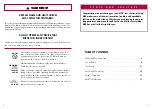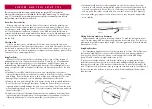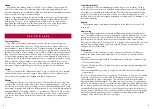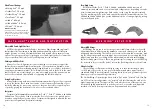
8
9
Staking
As with any tent, always anchor your MSR
®
tent or shelter to the ground with
stakes. This will prevent it from blowing away in the wind and maintain the tent’s
structural integrity in foul weather. Most MSR tents and shelters have additional stake
loops to increase security in windy conditions.
Because of varied ground and the tension needed to keep your shelter tight, stakes
need to be firmly planted. MSR supplies general-purpose stakes that work well in
hard ground. For snow, soft or sandy ground, or high winds, you may need to
supplement the holding power of the stakes with rocks or by using larger stakes.
MSR also offers specialized stakes that are best for those conditions.
Preventing Mildew
One of the easiest ways to damage your tent or shelter is by not drying it as
quickly as possible when it gets wet. Storing a wet tent for as little as 24 hours in
warm weather is likely to start the process of mildew forming on the fabric. Mildew
can permanently damage the waterproof coatings by causing them to separate from
the fabric, but mild to severe staining is more common. Mildew stains are permanent.
They cannot be removed without potential harm to the fabric coatings, and they are
not covered by warranty. Even when your tent or shelter appears to be dry after use,
it is always best to unfold at home and make sure it is completely dry before storing.
Pitch your shelter, hang it outside, or even leave it loosely clumped in your house
for a few days. After a day or two, turn it inside and out to ensure that it has dried
everywhere. Never machine dry your shelter, as the heat can melt the fabric.
Storing
Store your shelter in the stuff sack and place it in a cool, dry area out of sunlight
and away from heat sources and rodents. Open and air out your shelter at least
every six months to prevent odor buildup and fabric deterioration.
Cleaning
Cleaning your shelter is not necessary unless it has an offensive odor or becomes
heavily soiled. If heavily soiled, the pressure from a regular garden hose will remove
most loose dirt. For more serious cleaning, set up your shelter and hand wash it with
warm water, a sponge, and mild, non-detergent soap. Do not use dishwashing liquid,
detergent, bleach, pre-soaking solutions, or spot removers. Rinse well. Dry your tent
or shelter by pitching or line dry. Never dry clean, machine wash, or machine dry
your shelter. Any of these methods can remove all the waterproof coatings from
the fabric.
Sun & Ultraviolet Rays
UV light is one of the most damaging elements for your tent or shelter. Though
shelters are often used in the sun, extended and prolonged exposure will cause fab-
rics to fade, lose strength, and eventually tear. The effects are more rapid at higher
elevations. If possible, pitch your tent or shelter out of direct sunlight and use your
rainfly to help protect the more fragile netting and uncoated nylon. UV damage is not
covered by warranty.
Animals
To prevent damage from animals chewing holes in the fabric, never store food
in your tent.
Seam Sealing
Superior fabrics and construction make MSR tents and shelters extremely water-
proof. The rainfly and floor are factory seam-taped or have a binding tape, so seam
sealing is not necessary or recommended. If any problems develop, seam seal the
specific area only. Follow the instructions on the seam-sealer tube. Seam seal the
inner, coated, shiny side of the area only. Use a syringe for accuracy. Allow the seam
sealer to dry, then apply baby or talcum powder to prevent the seam sealer from
sticking to the rest of the shelter.
Condensation
Condensation is the buildup of moisture inside your shelter due to differences
between the inside and outside temperature. In your shelter, it is caused by three
main sources:
• Weather conditions: High humidity, low temperatures, and rainy conditions create
the most condensation.
• People: We produce about 1-2 pints of moisture in a night through breathing and
skin evaporation.
• Wet environment: Wet ground or wet gear stored inside the shelter will increase
condensation.
The key to reducing condensation is ventilation. Fresh air has to flow into your shelter,
and warm, moist air has to escape. MSR has designed a variety of features and
options that allow for interior ventilation. First, tent bodies and ceilings are made of
breathable fabric and MicroMesh
™
. This allows moisture to escape, so condensation
will be on the waterproof rainfly, not inside the tent. In addition, many MSR tents and
shelters have a peak vent, which provides protection from the elements but still allows
essential free-flowing, fresh air into your tent. Guying-out your tent with the guy-outs
will also increase ventilation in hot or humid conditions. Unfortunately, no tent design
will totally eliminate condensation in all conditions, but providing good ventilation
using any of the above tips will help in reducing it.
U S E A N D C A R E



























